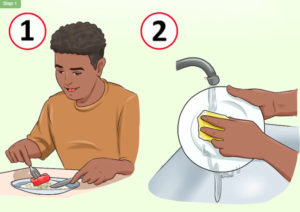
1.Clean up after each meal. Meal preparation and eating can make a mess in the kitchen. One of the best ways to keep your kitchen clean is to clean food and dishes after each meal. That way, messes don’t pile up, and you have a clean kitchen to work with at the start of your next meal. After each meal:
- Clear the table
- Transfer leftovers to airtight containers and store them in the refrigerator or freezer
- Wash, dry, and put away all the dishes
- Run the dishwasher when it’s full
- Clean spills, crumbs, and messes from the stove, floors, table, and counters
- Wash out the sink
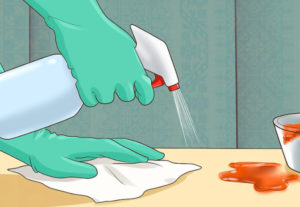
2.Clean spills when they occur. Another easy way to keep your kitchen clean and prevent stains, mold, and other problems is to address spills as soon as they happen. For food spills, use a spoon or cloth to clean up solid waste. Clean up excess liquids or sauces with a cloth. Spray the area with an all-purpose cleaner and wipe it dry.
- When spills involve raw meat, use a disinfecting spray to clean the mess to prevent the spread of bacteria.
- Cleaning liquid spills from the floor is also important for safety, because a wet floor is a slipping hazard.
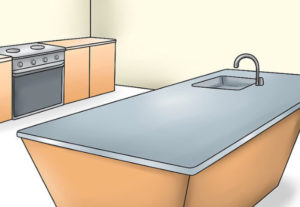
3.Clear off your countertops. Having empty counters is a great way to keep a kitchen looking neat and organized, and it also gives you more space for food preparation and other work.Here are some ideas for clearing cluttered counters:
- Store small appliances like toasters and coffeemakers in cupboards
- Keep non-refrigerated produce in a fruit bowl on the kitchen table
- Designate a special drawer for random items that are often used in the kitchen, like pens, paper, and mail
- Find a permanent home for all pots, pans, and kitchenware
- Store all ingredients, including often-used flour and sugar, in the pantry
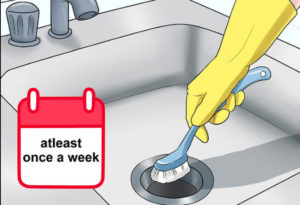
4.Clean your garbage disposal regularly. The garbage disposal can harbor dangerous bacteria and offensive smells, but regular cleaning will prevent this. Clean the disposal at least once a week by:
- Filling an ice cube tray with vinegar
- Pouring baking soda into the waste disposal
- Turning on the water and running the waste disposal
- Pouring the frozen vinegar cubes down the waste disposal
- Letting the disposal run until all the baking soda and cubes are gone

5.Sweep the floor daily. Kitchen floors get messy very quickly with dust, crumbs, food particles, and other matter. To keep the floor clean, sweep or vacuum the floor in the kitchen every evening after the final meal, or each morning before breakfast.[8]
- Sweeping regularly around the whole house will help minimize dust and allergens throughout the house as well.

6.Wash the floor weekly. On top of daily sweeping, you should also mop the floor every week to keep the floor clean. Mopping will remove dirt, spills, sticky spots, and other messes from the floor. Fill a bucket with soapy water and use a sponge or mop to wash the entire kitchen floor.
- Allow the floor to dry fully before walking on it again to prevent slips and footmarks on the floor.
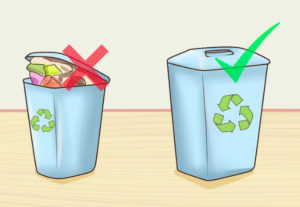
7.Use garbage and recycling containers that are the right size. Every family has different needs in terms of garbage and recycling containers. Replace your containers with larger ones if you find your garbage is often overflowing, that items often fall out and present tripping hazards, or if you have to empty the containers daily.
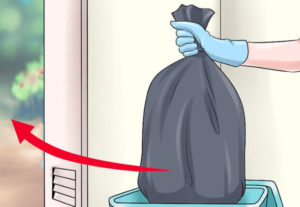
8.Take the garbage and recycling out when they’re full. To keep your kitchen clean, bug-free, and odor-free, tie up full garbage and recycling bags and take them out to the garage or another secondary storage area until it’s time for pickup.
- When you take out the garbage, wipe down the inside and outside of the can or bin with an all-purpose cleaner. Let the can dry before adding a fresh bag.
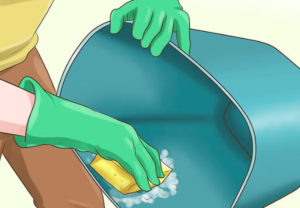
9.Clean and disinfect your garbage can regularly. Because your garbage can stores trash and food waste, it can harbor mold, mildew, smells, and bacteria. It’s important to clean and disinfect your garbage can once a month to keep your kitchen clean and sanitary. To clean the can thoroughly:[11]
- Rinse the can outside with a hose or in the bathtub
- Spray the inside and outside with an enzymatic or disinfecting spray
- Put on gloves and scrub the inside and outside of the can
- Rinse the can with clean water
- Pat the can dry or let it air dry outside
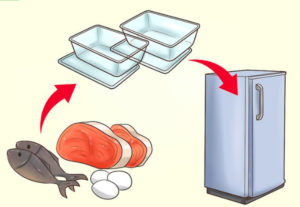
10.Refrigerate raw meat, fish, and dairy. These are temperature-sensitive foods that are prone to bacteria and spoilage. Always keep meat, fish, and dairy in the refrigerator if you’re going to use them within a few days, or in the freezer for longer storage.
- Transfer meat and fish to air-tight containers or freezer bags before storing to keep them fresh for longer. This will also prevent the spread of bacteria to other foods.
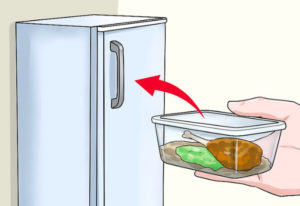
11.Refrigerate leftovers right away. Leftover food is great for lunch tomorrow, but to keep yourself and your family safe, it must be refrigerated immediately to prevent bacterial growth. As soon as the food stops steaming, transfer it to an airtight container and put it in the refrigerator or freezer.